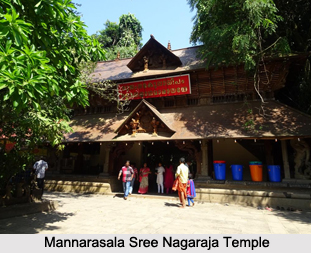 Mannarasala Sree Nagaraja Temple is also a centre of pilgrimage for the devotees of Nagaraja. It is located in a forest glade. The temple has over 30,000 images of snakes along the paths and among the trees. It is the largest snake temple in Kerala. Women seeking fertility come to worship and upon the birth of their child conduct thanksgiving ceremonies here. They bring new snake images as offerings.
Mannarasala Sree Nagaraja Temple is also a centre of pilgrimage for the devotees of Nagaraja. It is located in a forest glade. The temple has over 30,000 images of snakes along the paths and among the trees. It is the largest snake temple in Kerala. Women seeking fertility come to worship and upon the birth of their child conduct thanksgiving ceremonies here. They bring new snake images as offerings.
Legends of Mannarasala Sree Nagaraja Temple
The temple is located at Haripad, in Alappuzha district of Kerala. The story on the evolution of Mannarasala is associated with Lord Parashurama who is believed to be the creator of Kerala. Parashurama in order to release himself from the sin of killing Kshatriyas approached the several holy sages. They suggested that he should gift a land to the Brahmins. Parashurama propitiated Varuna to get some land for himself. He threw the axe which Lord Shiva gave him into the sea. He reclaimed the land from the sea and gave it as a gift to the Brahmins. This land is known as Kerala. However no one can survive on this land due to its salinity. Bharghavarama was pained and he undertook a penance to please Lord Shiva. Shiva advised him that the objective could be realized only if the flaming poison of the serpents was spread into the soil. This could be done by worshipping Nagaraja. Parashurama went out in search of a deserted jungle in order to please Nagaraja. In southern part of Kerala he found a suitable. He found a suitable place near the seashore in the southern part of Kerala. There he constructed a Thirthasthala for performing the penance.
Nagaraja was pleased who appeared before Parashurama. Nagaraja granted his request and ferocious serpents arrived at the spot and spread the flaming Kalakuda poison. As the poison percolated the land of Kerala was desalinated thereby making it habitable.
According to the Vedic rites Parashurama installed Nagaraja and that place is now known as Mannarasala. The installed deity here is Anantha (Vishnuswaroopa) and Vasuki (Siva in spirit). The Naga deities like Sarpayakshi, Nagayakshi and Nagachamundi were installed with proper rituals.
The family was grief stricken as they had no child. Vasudeva and Sreedevi had to bear that heavy load of sorrow and worshipped Nagaraja to calm their grief. Fire broke out in the jungle around the dwelling place of Nagaraja and burnt down the jungle. The serpents were tortured that forced them to hide in their pits with great difficulty. Vasudeva and Sreedevi looked after the serpents. They fanned them with fans made of sweet-scented grass and poured ghee mixed with honey and oil on the wounds in order to comfort them. They had put them at the foot of banyan trees. Purification ceremonies were performed. The couple performed abhisheka, observed elaborate poojas. Nagaraj was pleased and appeared before the couple and blessed them that he would incarnate on the earth as their beloved son.
Mannarasala is filled with Mandara trees, the holy spot where the serpents got shelter. The Brahmin lady gave birth to five-hooded serpent-child as well as a human child.
Mannarsala Aayilyam
Mannarsala Aayilyam is major Temple Festival. On the day of Aayilyam in the months September and October all the serpent idols in the grove and the temple are taken in procession to the family connected with the temple where the offerings of Nurum Palum, Kuruthi and cooked rice are made. The oldest female member of the family carries the Nagaraja idol and the procession is conducted with great pomp.











